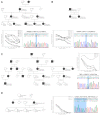Searching for the Molecular Basis of Partial Deafness
- PMID: 35682719
- PMCID: PMC9181477
- DOI: 10.3390/ijms23116029
Searching for the Molecular Basis of Partial Deafness
Abstract
Hearing is an important human sense for communicating and connecting with others. Partial deafness (PD) is a common hearing problem, in which there is a down-sloping audiogram. In this study, we apply a practical system for classifying PD patients, used for treatment purposes, to distinguish two groups of patients: one with almost normal hearing thresholds at low frequencies (PDT-EC, n = 20), and a second group with poorer thresholds at those same low frequencies (PDT-EAS, n = 20). After performing comprehensive genetic testing with a panel of 237 genes, we found that genetic factors can explain a significant proportion of both PDT-EC and PDT-EAS hearing losses, accounting, respectively, for approx. one-fifth and one-half of all the cases in our cohort. Most of the causative variants were located in dominant and recessive genes previously linked to PD, but more than half of the variants were novel. Among the contributors to PDT-EC we identified OSBPL2 and SYNE4, two relatively new hereditary hearing loss genes with a low publication profile. Our study revealed that, for all PD patients, a postlingual hearing loss more severe in the low-frequency range is associated with a higher detection rate of causative variants. Isolating a genetic cause of PD is important in terms of prognosis, therapeutic effectiveness, and risk of recurrence.
Keywords: PDT-EAS; PDT-EC; cochlear implantation; gene; genetics; hearing loss; high-throughput sequencing; partial deafness; pathogenic variant.
Conflict of interest statement
The authors declare no conflict of interest.
Figures



Similar articles
-
Expansion of phenotypic spectrum of MYO15A pathogenic variants to include postlingual onset of progressive partial deafness.BMC Med Genet. 2018 Feb 27;19(1):29. doi: 10.1186/s12881-018-0541-9. BMC Med Genet. 2018. PMID: 29482514 Free PMC article.
-
Genetic Inheritance of Late-Onset, Down-Sloping Hearing Loss and Its Implications for Auditory Rehabilitation.Ear Hear. 2020 Jan/Feb;41(1):114-124. doi: 10.1097/AUD.0000000000000734. Ear Hear. 2020. PMID: 31045651
-
A Novel Variant in SYNE4 Confirms its Causative Role in Sensorineural Hearing Loss.Balkan Med J. 2018 Mar 15;35(2):196-198. doi: 10.4274/balkanmedj.2017.0946. Epub 2017 Sep 29. Balkan Med J. 2018. PMID: 28958982 Free PMC article.
-
Monogenic Causes of Low-Frequency Non-Syndromic Hearing Loss.Audiol Neurootol. 2023;28(5):327-337. doi: 10.1159/000529464. Epub 2023 Apr 28. Audiol Neurootol. 2023. PMID: 37121227 Review.
-
Recessive LOXHD1 variants cause a prelingual down-sloping hearing loss: genotype-phenotype correlation and three additional children with novel variants.Int J Pediatr Otorhinolaryngol. 2021 Jun;145:110715. doi: 10.1016/j.ijporl.2021.110715. Epub 2021 Apr 20. Int J Pediatr Otorhinolaryngol. 2021. PMID: 33892339 Review.
References
-
- Skarzynski H., Lorens A., Piotrowska A., Skarzynski P.H. Hearing preservation in partial deafness treatment. Med. Sci. Monit. 2010;16:CR555–CR562. - PubMed
-
- Skarzynski H., Lorens A., D’Haese P., Walkowiak A., Piotrowska A., Sliwa L., Anderson I. Preservation of residual hearing in children and post-lingually deafened adults after cochlear implantation: An initial study. ORL J Otorhinolaryngol. Relat. Spec. 2002;64:247–253. doi: 10.1159/000064134. - DOI - PubMed
-
- Lenarz T. Cochlear implants: Selection criteria and shifting borders. Acta Otorhinolaryngol. Belg. 1998;52:183–199. - PubMed
MeSH terms
Substances
Grants and funding
LinkOut - more resources
Full Text Sources
Medical

